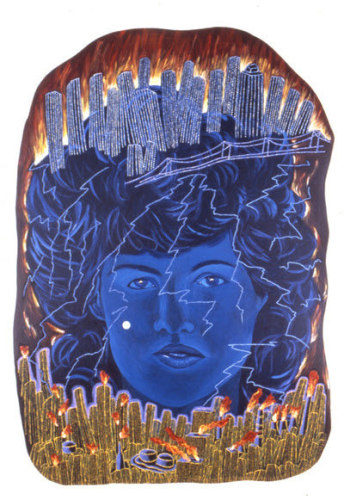Janet Cooling Reviewed in John Haber Art Reviews
Going Nuclear

From 1978 to 1982, Janet Cooling painted a single extended nightmare. Coming to New York from Chicago just in time for the AIDS crisis, she must have felt that she was living one as well. Just once, though, she shows herself caught up in a waking dream. She appears to relish it, too, and to have slept on her back. Her face looks upward, teeth bared in predatory pleasure, and oh what she sees or dreams. She is looking directly at her future and imagining what she has left behind.
Just above, apartment towers have a bleak but gorgeous anonymity. They lean back, as in an amateur photograph that tilts upward to take in tall buildings. Cooling never much cares to correct her mistakes, not when they take her so deep into a dream. They could be literally collapsing, and for a moment one could mistake her entire city for the twin towers on 9/11—or they could be rising, twisting, and alive. In other paintings, they are also on fire, like candles in the night, and a Chicago resident was sure to remember riots and burning. An African American, Purvis Young, has relied on similar images for his energy in LA.
Hers, though, are still halfway idyllic, even at their worst. Elsewhere, stags and other animals leap across the chasm between buildings, as if catastrophe could return humanity to Eden. New York had its crime in those years, but also its enclaves like much of Manhattan before it was no longer affordable and Central Park before it drew a crowd. At the center of another painting, couples cross a green world. In the dream itself, suburban tract housing from her childhood fills the space below her head. She might take relief from catastrophe in her memories, or she might be grateful to have moved on.
She must have been grateful to find herself in New York as an artist and a sexual being. The bare teeth mark her as a demon lover. If that sounds stereotypical for a woman, Cooling is delighted to play against stereotype. It makes her dark myths that much more fun. Often a large woman's head dominates a shaped panel close to an oval, like an eighteenth-century portrait but with trendier hair. At the center of still another painting, a couple is plainly having sex.
Then again, nothing in a dream is quite plain. She is asserting herself as queer, but that couple has no obvious gender, and those on the grass are mixed. The first AIDS cases did not appear until 1981, but Cooling had no shortage of nightmares all along. Cars crossing a painting look more savage than the stags, and nuclear towers look worse. She remembered them from growing up in New Jersey, and, the gallery suggests, nukes had to be on her mind late in the Cold War. If nothing else, they supply the paintings with radioactive colors, like the heads in a downright fiery blue.
The gallery also compares her to David Wojnarowicz. Still, Wojnarowicz before AIDSlayered on his colors, while Cooling's glow from within. Later, she amped up the reds and oranges in faces, for a Neo-Expressionism closer to Sandro Chia. Then she amped up the bodies, including male bodies, and more recently she has brighter landscapes far from cities, at once harsher and more idyllic. Still, nothing since goes anywhere near as sensual or as nuclear as those first four years. She was dreaming, but always wide awake.
— John Haber
John Haber Art Reviews | Going Nucelar